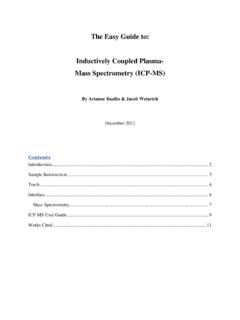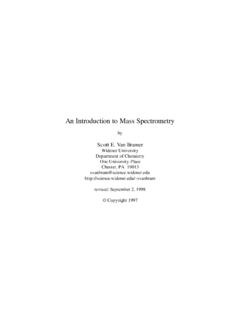Transcription of Method 625.1: Base/Neutrals and Acids by GC/MS (2016)
1 Office of Water EPA 821-R-16-007. December 2016. Method : Base/Neutrals and Acids by GC/MS . This document contains the text of Method as published in 40 CFR part 136, Appendix A;. but formatted as a more user friendly stand-alone document. Please address questions or comments to: CWA Methods Team Engineering and Analytical Support Branch/EAD (4303T). Office of Science and Technology Environmental Protection Agency 1200 Pennsylvania Avenue, NW. Washington, DC 20460. Method Base/Neutrals and Acids by GC/MS . 1. Scope and Application This Method is for determination of semivolatile organic pollutants in industrial discharges and other environmental samples by gas chromatography combined with mass spectrometry ( GC/MS ), as provided under 40 CFR This revision is based on a previous protocol (Reference 1), on the basic revision promulgated October 26, 1984 (49 FR 43234), and on an interlaboratory Method validation study (Reference 2). Although this Method was validated through an interlaboratory study conducted in the early 1980s, the fundamental chemistry principles used in this Method remain sound and continue to apply.
2 The analytes that may be qualitatively and quantitatively determined using this Method and their CAS Registry numbers are listed in Tables 1 and 2. The Method may be extended to determine the analytes listed in Table 3; however, extraction or gas chromatography of some of these analytes may make quantitative determination difficult. For example, benzidine is subject to oxidative losses during extraction and/or solvent concentration. Under the alkaline conditions of the extraction, alpha-BHC, gamma-BHC, endosulfan I and II, and endrin are subject to decomposition. Hexachlorocyclopentadiene is subject to thermal decomposition in the inlet of the gas chromatograph, chemical reaction in acetone solution, and photochemical decomposition. N- nitrosodiphenylamine and other nitrosoamines may decompose in the gas chromatographic inlet. The sample may be extracted at neutral pH if necessary to overcome these or other decomposition problems that could occur at alkaline or acidic pH.
3 EPA also has provided other methods ( , Method 607 Nitrosamines) that may be used for determination of some of these analytes. EPA. encourages use of Method to determine additional compounds amenable to extraction and GC/MS . The large number of analytes in Tables 1 - 3 of this Method makes testing difficult if all analytes are determined simultaneously. Therefore, it is necessary to determine and perform quality control (QC) tests for the analytes of interest only. Analytes of interest are those required to be determined by a regulatory/control authority or in a permit, or by a client. If a list of analytes is not specified, the analytes in Tables 1 and 2 must be determined, at a minimum, and QC testing must be performed for these analytes. The analytes in Tables 1 and 2, and some of the analytes in Table 3 have been identified as Toxic Pollutants (40 CFR ), expanded to a list of Priority Pollutants (40 CFR part 423, appendix A). In this revision to Method 625, the pesticides and polychlorinated biphenyls (PCBs) have been moved from Table 1 to Table 3 (Additional Analytes) to distinguish these analytes from the analytes required in quality control tests (Tables 1 and 2).
4 QC acceptance criteria for pesticides and PCBs have been retained in Table 6 and may continue to be applied if desired, or if requested or required by a regulatory/control authority or in a permit. Method should be used for determination of pesticides and PCBs. However, if pesticides and/or PCBs are to be determined, an additional sample must be collected and extracted using the pH adjustment and extraction procedures specified in Method Method 1668C may be useful for determination of PCBs as individual chlorinated biphenyl congeners, and Method 1699 may be useful for determination of pesticides. At the time of writing of this revision, Methods 1668C and 1699 had not been approved for use at 40 CFR part 136. The screening procedure for 2,3,7,8-tetrachlorodibenzo-p-dioxin (2,3,7,8-TCDD) contained in the version of Method 625 promulgated October 26, 1984 (49 FR. 43234) has been replaced with procedures for selected ion monitoring (SIM), and 2,3,7,8-TCDD. may be determined using the SIM procedures.
5 However, EPA Method 613 or 1613B should be Method 1 December 2016. used for analyte-specific determination of 2,3,7,8-TCDD because of the focus of these methods on this compound. Methods 613 and 1613B are approved for use at 40 CFR part 136. Method detection limits (MDLs; Reference 3) for the analytes in Tables 1, 2, and 3 are listed in those tables. These MDLs were determined in reagent water (Reference 4). Advances in analytical technology, particularly the use of capillary (open-tubular) columns, allowed laboratories to routinely achieve MDLs for the analytes in this Method that are 2 - 10 times lower than those in the version promulgated in 1984 (49 FR 43234). The MDL for an analyte in a specific wastewater may differ from those listed, depending upon the nature of interferences in the sample matrix. EPA has promulgated this Method at 40 CFR part 136 for use in wastewater compliance monitoring under the National Pollutant Discharge Elimination System (NPDES). The data reporting practices described in Section are focused on such monitoring needs and may not be relevant to other uses of the Method .
6 This Method includes reporting limits based on EPA's minimum level (ML) concept (see the glossary in Section 22). Tables 1, 2, and 3 contain MDL values and ML values for many of the analytes. This Method is performance-based. It may be modified to improve performance ( , to overcome interferences or improve the accuracy of results) provided all performance requirements are met. Examples of allowed Method modifications are described at 40 CFR Other examples of allowed modifications specific to this Method , including solid-phase extraction (SPE) are described in Section Any modification beyond those expressly permitted at 40 CFR or in Section of this Method shall be considered a major modification subject to application and approval of an alternate test procedure under 40 CFR and For regulatory compliance, any modification must be demonstrated to produce results equivalent or superior to results produced by this Method when applied to relevant wastewaters (Section ). This Method is restricted to use by or under the supervision of analysts experienced in the use of a gas chromatograph/ mass spectrometer and in the interpretation of mass spectra.
7 Each laboratory that uses this Method must demonstrate the ability to generate acceptable results using the procedure in Section Terms and units of measure used in this Method are given in the glossary at the end of the Method . 2. Summary of Method A measured volume of sample, sufficient to meet an MDL or reporting limit, is serially extracted with methylene chloride at pH 11 - 13 and again at a pH less than 2 using a separatory funnel or continuous liquid/liquid extractor. The extract is concentrated to a volume necessary to meet the required compliance or detection limit, and analyzed by GC/MS . Qualitative identification of an analyte in the extract is performed using the retention time and the relative abundance of two or more characteristic masses (m/z's). Method 2 December 2016. Quantitative analysis is performed using the internal standard technique with a single characteristic m/z. 3. Contamination and Interferences Solvents, reagents, glassware, and other sample processing labware may yield artifacts, elevated baselines, or matrix interferences causing misinterpretation of chromatograms and mass spectra.
8 All materials used in the analysis must be demonstrated to be free from contamination and interferences by analyzing blanks initially and with each extraction batch (samples started through the extraction process in a given 24-hour period, to a maximum of 20 samples - see Glossary for detailed definition), as described in Section Specific selection of reagents and purification of solvents by distillation in all-glass systems may be required. Where possible, labware is cleaned by extraction or solvent rinse, or baking in a kiln or oven. Glassware must be scrupulously cleaned (Reference 5). Clean all glassware as soon as possible after use by rinsing with the last solvent used in it. Solvent rinsing should be followed by detergent washing with hot water, and rinses with tap water and reagent water. The glassware should then be drained dry, and heated at 400 C for 15 - 30 minutes. Some thermally stable materials, such as PCBs, may require higher temperatures and longer baking times for removal.
9 Solvent rinses with pesticide quality acetone, hexane, or other solvents may be substituted for heating. Do not heat volumetric labware above 90 C. After drying and cooling, store inverted or capped with solvent- rinsed or baked aluminum foil in a clean environment to prevent accumulation of dust or other contaminants. Matrix interferences may be caused by contaminants co-extracted from the sample. The extent of matrix interferences will vary considerably from source to source, depending upon the nature and diversity of the industrial complex or municipality being sampled. Interferences extracted from samples high in total organic carbon (TOC) may result in elevated baselines, or by enhancing or suppressing a signal at or near the retention time of an analyte of interest. Analyses of the matrix spike and duplicate (Section ) may be useful in identifying matrix interferences, and gel permeation chromatography (GPC; Section ) and sulfur removal (Section ) may aid in eliminating these interferences.
10 EPA has provided guidance that may aid in overcoming matrix interferences (Reference 6). In samples that contain an inordinate number of interferences, the use of chemical ionization (CI). or triple quadrupole (MRM) mass spectrometry may make identification easier. Tables 4 and 5. give characteristic CI and MRM m/z's for many of the analytes covered by this Method . The use of CI or MRM mass spectrometry may be utilized to support electron ionization (EI) mass spectrometry or as a primary Method for identification and quantification. While the use of these enhanced techniques is encouraged, it is not required. 4. Safety Hazards associated with each reagent used in this Method have not been precisely defined;. however, each chemical compound should be treated as a potential health hazard. From this viewpoint, exposure to these chemicals must be reduced to the lowest possible level by whatever means available. The laboratory is responsible for maintaining a current awareness file of OSHA.














